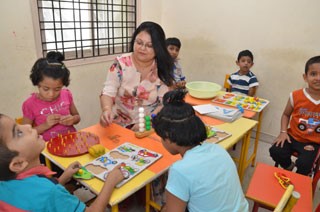The world’s best chef runs a three-starred Michelin restaurant in Modena, Italy. He also cooks for the homeless
This year, Chef Massimo Bottura’s restaurant, Osteria Francescana, was ranked No 1 by The World’s 50 Best Restaurants awards. You may know him from the Netflix original series: Chef’s Table. What you may not know is the Italian chef also founded the non-profit association ‘Food for Soul’ to empower communities to fight food waste, with thoughtfully designed community kitchens in Milan, Rio de Janeiro, London and Paris. All part of his inspiring crusade to use art, design and food to transform spaces and people.
In Rio de Janeiro, at the 2016 Olympic games, Refettorio Gastromotiva, his first International community kitchen was launched. It aimed to promote social integration using surplus food and celebrity chefs to tackle food waste and nourish the city’s poorest. (Refettorio comes from the Latin reficere, meaning ‘to re-make’, and also ‘to restore.’) Essential work in a world where one-third of the food we produce is thrown away and over 800 million people are undernourished. Food for Soul has also opened Refettorio Ambrosiano in Milan, Refettorio Felix in London and Refettorio Paris. So far they have cooked 450,000 dishes, served 150,000 guests and recovered 45 tonnes of food by sourcing quality, in-date ingredients that are perfectly edible but would otherwise go to waste.
Chef Massimo recently released Bread Is Gold, tackling food waste with creativity and the star power of 65 chefs, including Daniel Humm, Alain Ducasse and René Redzepi. Recently speaking at a Slow Food Nations Chef Summit, he discussed the importance of food rescue. Like Slow Food’s pioneers, he believes food can provoke change and tells MetroPlus why this is the age of the activist chef.
Chefs around the world are getting involved in cultural projects and working towards positive changes in society. You’ve been a trailblazer here: why is it important to engage with communities?
Chefs today are influencers, and therefore they have a responsibility to help their communities grow and become more sustainable. Part of this growth is the fight against food waste and hunger.
It’s time for us to go outside our kitchens and listen to our communities, to give back what we have learned in years of hard work, sacrifice, but also satisfactions and rewards. We chefs are as responsible as everyone else to make the difference, and we have to do it now. Not tomorrow, not within a couple of months. Cooking is a call to act.
Refettorio Ambrosiano: Set in an abandoned theatre in the suburbs of Milan, this community kitchen welcomes the socially vulnerable and offers a daily three-course dinner service, prepared with surplus ingredients collected from markets and supermarkets across Milan | Photo Credit: Caritas Ambrosiana
Why choose to focus on food waste? And what strategies should home cooks adopt?
The most valuable lesson of the Italian kitchen is to never throw anything away: no crumbs or bones ever get thrown in the bin. Just think about bread. There are recipes for breadcrumb soups, loaves, meatballs, flans made with bread, not to mention the pasta-like ‘passatelli’. My favourite dinner as a kid, was milk soup: basically made with huge chunks of stale bread that I used to dunk in a bowl of warm milk, with only that sip of coffee left from the moka machine, and lots of sugar. I mean, loads. Delicious.
When we opened the first Food for Soul’s project, Refettorio Ambrosiano, I invited my chef friends to join us and cook with food surplus coming from the Universal Exposition. We found ourselves with tons of innovative recipes that we wanted to share. Which is why we published a book called Bread is Gold. It is a cookbook collecting stories of the challenge faced while making lunch for kids and dinner for homeless guests out of very humble ingredients. It is just amazing to read about Rene Redzepi’s popcorn pesto. Or Ferran and Albert Adria cooking together for school children. Or Alain Ducasse making meatballs in the walk-in refrigerator because it was too hot in the kitchen. These are the kind of recipes that make you want to get into the kitchen. Bread is Gold is a metaphor for giving value to the simplest things in life that we often overlook. It is a way of looking at the world, looking at your pantry and finding inner beauty in the humblest ingredient.
Refettorio Paris: Dining area curated by architect Nicola Delon and designer Ramy Fischler, and enriched by installations from renewed artists JR and Prune Nourry | Photo Credit: JR
Is there a similar philosophy behind the running of Osteria Francescana and the Refettorio kitchens, even though their target audience is so different? For you, which kitchen is more challenging?
Every kitchen has a way of working. The Italian kitchen has traditionally been one where very little is wasted. Every part of an animal is used, every part of a vegetable and even leftover ingredients are used. We practise this in our kitchen at Osteria Francescana and try to teach young chefs to be resourceful with ingredients; to have respect for not only the food that they are preparing, but also the food they eat daily. Our staff meals are healthy and fresh because we believe in the regenerative power of food.
You have said that the most important ingredient in a kitchen is culture. Why? And how has that idea moulded Food for Soul?
We have created a laboratory of ideas where we make culture on a daily basis: where we get in touch with farmers, artisans and fishmongers who grew up with us and share our philosophy.
Our kitchen is not a recipe book, a list of ingredients or a showcase of techniques: it is a narration of our landscape, our passions, our memories, and culinary heritage. Our research takes us in many different directions, but we constantly keep in mind where we are, in space and time, because this defines who we are. Culture brings knowledge. Knowledge leads to consciousness. And from consciousness, it only takes a little step to the sense of responsibility. It’s time for chefs to go outside their kitchens, with everything accumulated over years of not just experience, hard work and sacrifice, but also satisfaction and acknowledgement. Food for Soul is a cultural project, not a charity. Our aim is not to feed as many people as possible and recover as much food surplus as possible. We push for a change of mindset in people on urgent issues like food waste and social isolation. It means looking at the world with different eyes, and being responsible for it.
Refettorio Felix: Food for Soul partners with The Felix Project, a London-based food waste charity, to offer meals for the for the homeless and vulnerable in London. | Photo Credit: Simon John Owen Red Photographic
Over the past generations, there has been a gradual erosion of cooking skills, especially for people who have grown up with supermarkets and ready-to-eat meals. How do younger home cooks and chefs who may not even know how to deal with unfamiliar or stale ingredients tackle this?
Cooking is not only manual labour but also a thinking man’s job. And I can say exactly the same with eating. One of the most valuable ingredients or tools in the kitchen, and one often left behind, is the mind. Awareness: this is what it takes. A varied diet full of seasonal greens, fruits, legumes, cheese, grains, fish and meat is the best diet and the one I grew up with. Avoid processed foods. Shop regularly and buy fresh ingredients. Before buying more food, use the food you have in the refrigerator.
Then, make the best of ingredients at every stage of their lifespan. Straight out of the oven, a loaf of bread is good enough to be eaten as it is. The day after, it will be perfect to make pappa al pomodoro or bread pudding. After two days, the bread will make breadcrumbs for meatballs, passatelli and cakes. That’s what real beauty is: to make something valuable out of something that might be seen as not having any value at all.
| Delicious leftovers
Make soups with vegetables that are looking old or sad. Make fruit drinks or fruit breads and muffins with fruit that is too mature. Use up the meat in your freezer to prepare a ragout, meatloaf, meatballs, or baked pasta dish. Ugly fruits and vegetables can taste just as delicious as beautiful ones, and sometimes even more, like in the case of the brown (over mature) bananas, when used properly, to make gelato or banana bread. It is often said of a person that he or she is ‘beautiful inside’. A browned banana, a bruised fruit still has a huge potential in terms of smell, flavour, texture. The responsibility of the chef, as well as that of all of us cooking at home, is to find that inner beauty in each product. |








